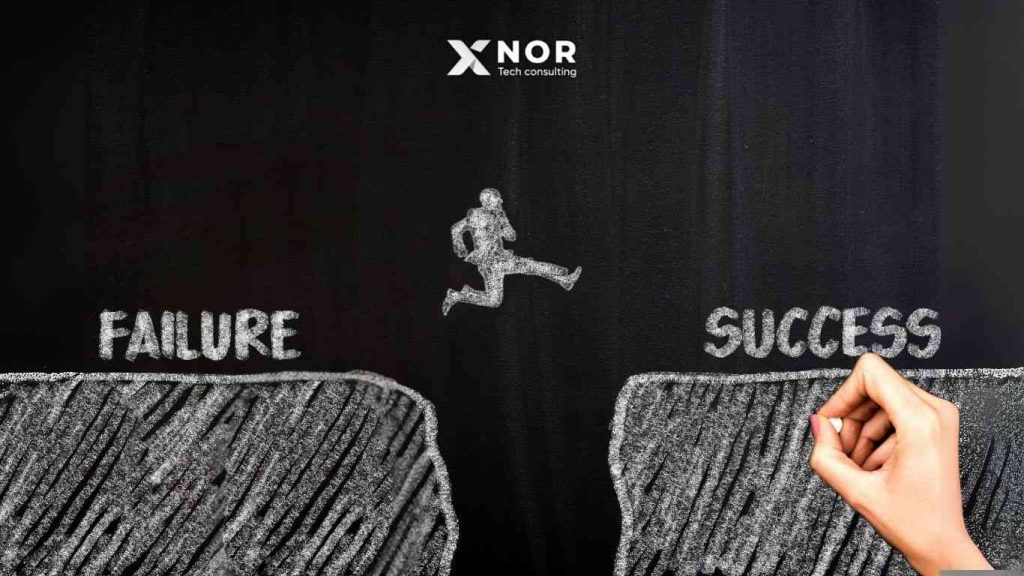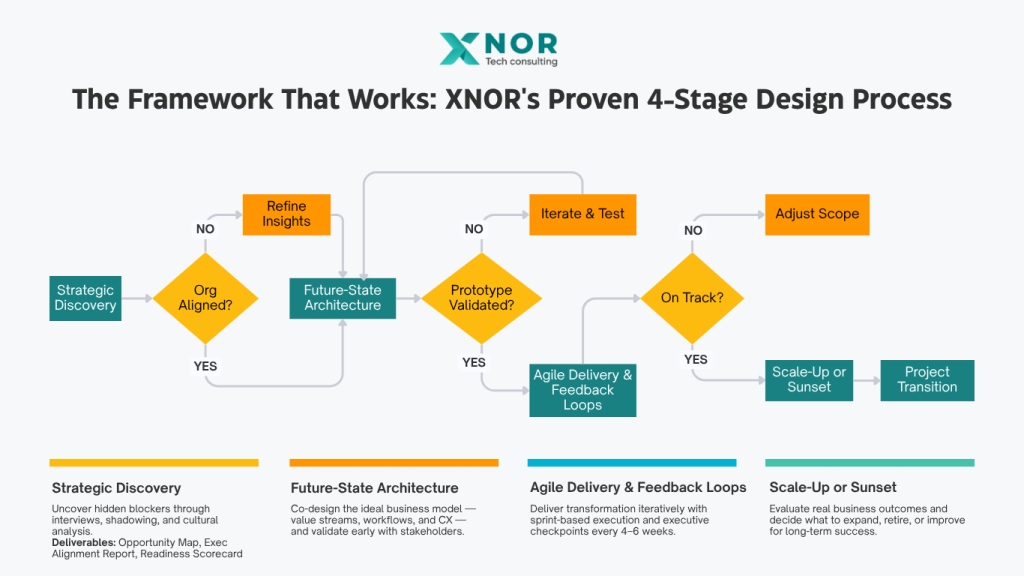Discover why most digital transformation consulting projects fail and learn the proven strategies that successful companies use. Get expert insights on business transformation, DX strategy, and implementation best practices that deliver real ROI.

The harsh reality? Furthermore, digital transformation consulting has become a massive global industry, yet the majority of initiatives fail to deliver their promised value. However, what separates the winners from the losers isn’t just technology—it’s asking the right question from day one: “Where is the right place to start?”
The Question Every Digital Transformation Consulting Project Should Address
Picture this: You’re the CEO of a mid-sized manufacturing company. Meanwhile, your competitors are gaining market share with digital solutions, your operational costs are rising, and your team is drowning in manual processes. Consequently, you decide it’s time for business transformation.
Months later, however, you have shiny new software that nobody uses, frustrated employees, and the same old problems. Sound familiar?
In fact, this scenario plays out in boardrooms worldwide every single day. The culprit? Specifically, starting digital transformation without proper digital transformation strategy consulting.
The Hidden Cost of Getting Business Transformation Wrong
Why Digital Transformation Consulting Projects Fail:
- First and foremost, lack of clear strategic roadmap and vision alignment
- Additionally, underestimating change management and cultural requirements
- Moreover, choosing technology solutions before understanding business needs
- Furthermore, insufficient leadership buy-in and executive commitment
- Finally, missing proper success metrics and measurement frameworks
As a result, the financial impact of failed digital transformation initiatives can be devastating, with costs ranging from hundreds of thousands to tens of millions of dollars, depending on company size and scope of the failed initiative.
What Should a Business Starting Digital Transformation Strategy Do First?
The Strategic Foundation: Assessment Before Action
Here’s what should happen before you even choose a tech stack:
1. Align C-Suite Incentives Around Digital Transformation Consulting
First, executives must see transformation not as a tech project but as a business reinvention. This means:
- Furthermore, shared KPIs between tech, operations, and finance
- Additionally, clear ownership over transformation outcomes
- Moreover, regular visibility into impact (not just progress)
Culture & Change Readiness Audit for Business Transformation
Obviously, digital transformation fails when employees don’t buy in. Therefore, we help clients:
- Initially, measure change readiness across teams
- Subsequently, identify hidden resistance zones (often middle management)
- Finally, build a clear internal communication strategy
3. Reimagine the Business Model First
Before automating, however, ask: Are we optimizing the wrong process?
- Should you move to a subscription model?
- Are legacy pricing structures killing growth?
- Are manual approval steps still needed?
Case example: Specifically, a healthcare SaaS client cut onboarding time by 73% by rethinking their patient intake model—rather than just digitizing old steps.
The Framework That Works: XNOR’s Proven 4-Stage Digital Transformation Consulting Approach
Our digital transformation management consulting is built on a proven 4-stage framework. Furthermore, here’s how it breaks down over 18 months:

Stage 1: Strategic Discovery (0–2 months)
Initially, we conduct interviews, shadow operations, and map out friction zones. Deliverables include:
- Transformation Opportunity Map
- Executive Alignment Report
- Culture Readiness Scorecard
Goal: Ultimately, uncover what’s really holding you back—before any tech is proposed.
Stage 2: Future-State Architecture (2–4 months)
Next, we co-design your desired future business model, including:
- Value streams
- Digital workflows
- Target customer experience (CX)
This includes early-stage solution prototypes (yes, Figma screens) to test with users and stakeholders – but without committing to code.
Stage 3: Agile Delivery & Feedback Loops (4–14 months)
This is where enterprise transformation gets dangerous—scope creep, misalignment, budget bloat. However, we avoid that with:
- Primarily, feature slicing tied to real business value (rather than just IT logic)
- Additionally, sprint-based delivery (agile or hybrid, depending on org size)
- Furthermore, executive review loops every 4–6 weeks
Stage 4: Scale-Up or Sunset (14–18 months)
Finally, we measure impact and make a clear decision:
- For instance, what gets scaled?
- Conversely, what gets sunset?
- Additionally, what still needs iteration?
Business transformation consulting services shouldn’t just end with implementation – instead, they must guide your long-term roadmap.
The Enterprise Digital Transformation Consulting Challenge
For enterprises with 10,000+ employees, transformation is less about tech and more about orchestration. Meanwhile, some unique pain points we solve:
| Challenge | Impact | XNOR’s Fix |
| Siloed Departments | Conflicting roadmaps, miscommunication | Cross-functional DX councils |
| Legacy Systems | High technical debt, low agility | Integration-first architecture |
| Fear of Change | Passive resistance, talent churn | Culture transformation sprints |
Consulting Business Transformation: Redefining Value Creation
Consulting business transformation goes beyond operational efficiency -instead, it’s about discovering new revenue streams and business models.
Revenue Model Innovation Examples:
- Manufacturing company becomes data-as-a-service provider
- Retail chain launches direct-to-consumer digital marketplace
- Professional services firm develops AI-powered automated solutions
- Traditional bank transforms into fintech platform
The ROI Reality: Measuring Digital Transformation Consulting Success
Beyond Vanity Metrics: What Actually Matters
Many digital transformation consulting services focus on technology adoption rates or system uptime. However, smart companies measure business impact instead.
Tier 1 Metrics (Business Impact):
- Primarily, revenue growth from digital channels
- Additionally, customer lifetime value increase
- Moreover, market share expansion
- Finally, new product/service launch speed
Tier 2 Metrics (Operational Efficiency):
- First, process cycle time reduction
- Second, error rate decrease
- Third, employee productivity gains
- Fourth, cost per transaction reduction
Tier 3 Metrics (Foundation):
- Initially, system uptime and performance
- Subsequently, user adoption rates
- Furthermore, training completion percentages
- Finally, security incident reduction
The 18-Month Success Timeline for Business Transformation
Realistic Expectations for Digital Transformation Consulting:
Months 1-6: Foundation Building
- Strategy development and stakeholder alignment
- Technology selection and procurement
- Pilot program launch
- Change management program initiation
Months 7-12: Implementation and Optimization
- Full-scale rollout execution
- Process refinement based on pilot learnings
- Advanced user training and support
- Performance monitoring and adjustment
Months 13-18: Scaling and Innovation
- Expansion to additional business units
- Advanced feature implementation
- Innovation lab establishment
- Continuous improvement culture embedding
How to Choose the Right Digital Transformation Consulting Partner
The Due Diligence Checklist
Not all digital transformation management consulting firms are created equal. Therefore, here’s how to separate the experts from the opportunists:
Experience and Expertise Evaluation:
- Industry-specific transformation track record
- Client reference checks and case studies
- Technical team credentials and certifications
- Change management methodology and tools
Approach and Methodology Assessment:
- Proven frameworks and best practices
- Agile and iterative implementation approach
- Risk management and mitigation strategies
- Post-implementation support and optimization
Cultural Fit and Collaboration Style:
- Communication style and frequency
- Willingness to transfer knowledge internally
- Flexibility and adaptability to unique requirements
- Long-term partnership orientation vs. project-only focus
Red Flags to Avoid in Digital Transformation Consulting
Warning Signs of Poor Digital Transformation Consultants:
- First, one-size-fits-all solutions without customization
- Second, technology-first approach without business strategy
- Third, lack of change management expertise
- Fourth, no clear success metrics or ROI projections
- Fifth, poor client references or case study portfolio
Getting Started: Your 30-Day Digital Transformation Readiness Plan
Before you hire a dev team or buy a platform, here’s what we recommend in the first 30 days:
Week 1:
- Stakeholder alignment workshop
- Identify transformation champions
Week 2:
- Culture readiness survey
- Map top 5 friction points in current process
Week 3:
- Ideate 3 alternative business models
- Draft north star transformation vision
Week 4:
- Prioritize 1–2 pilot areas
- Define success metrics (with finance & ops)
The Future-Proof Digital Transformation Strategy
Building Adaptive Capabilities for Continuous Evolution
The most successful digital transformations aren’t one-time projects—instead, they’re ongoing capabilities that enable continuous adaptation and innovation.
Key Components of Future-Proof Strategy:
- First, modular Architecture: Technology stack that can evolve with business needs
- Second, continuous Learning Culture: Organization-wide commitment to skill development
- Third, innovation Framework: Structured approach to testing and scaling new ideas
- Fourth, agile Governance: Decision-making processes that can adapt quickly to market changes
Conclusion: the right Starting Point Changes Everything

The difference between digital transformation success and the costly mistakes that plague 77% of initiatives comes down to one critical factor: starting with strategy before technology.
Digital transformation consulting isn’t about implementing the latest software or following industry trends. Instead, it’s about understanding your unique business context, aligning technology investments with strategic objectives, and building organizational capabilities that drive sustainable competitive advantage.
The companies that succeed in business transformation don’t rush into technology decisions. Rather, they invest time upfront in strategic planning, stakeholder alignment, and cultural preparation. Furthermore, they choose digital transformation management consulting partners who understand that lasting change requires more than technical expertise—specifically, it requires business acumen, change leadership, and a genuine commitment to client success.
Your digital transformation journey doesn’t have to join the 77% failure statistic. In fact, with the right approach, clear strategy, and expert guidance, your organization can achieve the operational efficiency, revenue growth, and competitive advantage that digital transformation promises.



